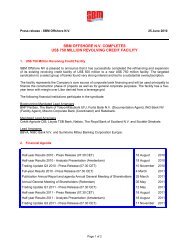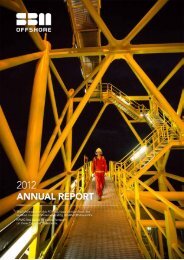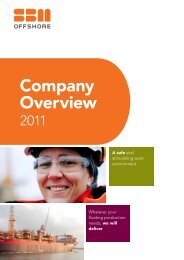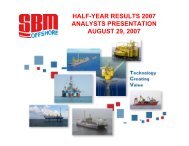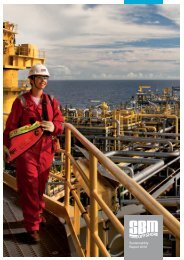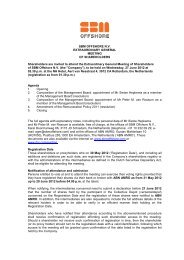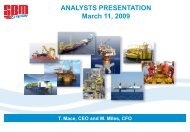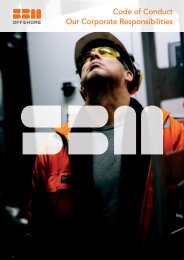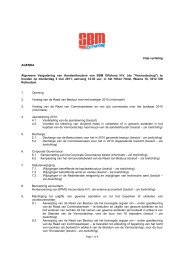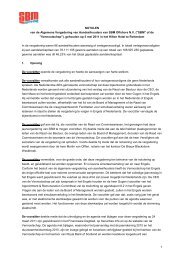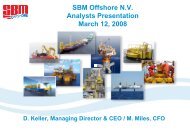1 DRAFT MINUTES of the Annual General Meeting ... - SBM Offshore
1 DRAFT MINUTES of the Annual General Meeting ... - SBM Offshore
1 DRAFT MINUTES of the Annual General Meeting ... - SBM Offshore
You also want an ePaper? Increase the reach of your titles
YUMPU automatically turns print PDFs into web optimized ePapers that Google loves.
included into <strong>the</strong> design <strong>of</strong> <strong>the</strong> system. For <strong>the</strong> big production facilities this is not really significant as an<br />
impact.<br />
Mr Jorna (VEB) said he had noticed that <strong>the</strong> operational margin with <strong>the</strong> Turnkey Systems historically was<br />
around 5%, while last year that had been 9%. Also, when he looked at <strong>the</strong> 2011 forecast, more pr<strong>of</strong>it would<br />
be generated than previously. His first question was what <strong>the</strong> reasons were for this. Fur<strong>the</strong>rmore, he<br />
referred to a discussion with a client on a contract. He indicated that certain "headache files" had been<br />
closed. He referred in particular to <strong>the</strong> Norwegian Talisman field and asked (second question) whe<strong>the</strong>r it<br />
had been closed and whe<strong>the</strong>r that would increase margins in <strong>the</strong> turnkey systems segment. Was <strong>SBM</strong><br />
capable <strong>of</strong> asking for higher margins or was this left to market operations <strong>the</strong>mselves? He also said that he<br />
had read about risks and he said that he himself considered <strong>the</strong>m conceivable for <strong>the</strong> oil companies which<br />
engage <strong>SBM</strong> for services or purchase vessels, particularly as regards leasing. He asked (third question)<br />
whe<strong>the</strong>r oil companies were not increasingly inclined to shrug <strong>of</strong>f responsibility, given <strong>the</strong> risks involved.<br />
Was <strong>SBM</strong> as leasing company responsible for what happens, and was <strong>SBM</strong> still capable <strong>of</strong> assuming risks<br />
even if markets were to take a downturn?<br />
The Chairman indicated that Mr Jorna had interesting questions. Mr Mace answered in relation to <strong>the</strong> first<br />
question, on <strong>the</strong> turnkey systems margins, that <strong>the</strong>re had been improvements from <strong>the</strong> prior two years and,<br />
as has been announced, <strong>the</strong>se improvements continued. There are two reasons, being (i) <strong>the</strong> underlying<br />
more robust performance on execution <strong>of</strong> projects and <strong>the</strong>refore <strong>the</strong> better margins and (ii) <strong>the</strong> financial<br />
lease accounting treatment <strong>of</strong> long-term leases, which has a knock-on effect in <strong>the</strong> turn key system result.<br />
He asked Mr Miles to add something to that. Mr Miles indicated additionally on <strong>the</strong> first question, that <strong>SBM</strong><br />
has a couple <strong>of</strong> long-term lease contracts, <strong>the</strong> terms <strong>of</strong> which imply that <strong>the</strong> lease contract is reported as a<br />
sale <strong>of</strong> an FPSO with a financing package attached to it. That means that part <strong>of</strong> <strong>the</strong> return which is rolled<br />
up into that lease contract is in fact reported as a turnkey systems sale during <strong>the</strong> construction phase <strong>of</strong> <strong>the</strong><br />
project. This means that part <strong>of</strong> <strong>the</strong> lease returns are brought forward into <strong>the</strong> construction phase, earlier<br />
than <strong>the</strong>y would o<strong>the</strong>rwise have been recognised. That impact is giving a booster on top <strong>of</strong> <strong>the</strong> improved<br />
performance on <strong>the</strong> underlying projects. Indeed two effects: (i) better underlying performance and (ii) an<br />
addition from <strong>the</strong> financial lease accounting treatment. Mr Mace replied to <strong>the</strong> second question related to<br />
<strong>the</strong> Norwegian project where <strong>SBM</strong> had impairments in <strong>the</strong> past and has announced in <strong>the</strong> Trading Update<br />
Press release <strong>of</strong> earlier in <strong>the</strong> day, that it has an outstanding financial situation in <strong>the</strong> project to conclude<br />
with <strong>the</strong> client. Mr Mace indicated that he cannot say more than that at this point. Mr Jorna may have been<br />
referring to <strong>the</strong> Canadian project, where <strong>SBM</strong> has a litigation process, which started earlier this year. Again,<br />
Mr Mace indicated that he was not able to say more at this time, as he does not want to jeopardize <strong>the</strong><br />
Company’s commercial position on those two projects. The last question (third question) related to <strong>the</strong><br />
leasing business and whe<strong>the</strong>r <strong>SBM</strong> inherits risks or takes on risks with <strong>the</strong>se lease contracts. Mr Mace<br />
indicated that <strong>the</strong> answer is yes, but that <strong>SBM</strong> tries to mitigate or insure to get indemnified for <strong>the</strong> risk. One<br />
<strong>of</strong> <strong>the</strong> biggest risks which <strong>SBM</strong> could be faced with is pollution and it is quite strict in always demanding and<br />
getting a full indemnity from <strong>the</strong> client for any pollution emanating from <strong>the</strong> vessel under any circumstance.<br />
Mr Van de Roemer indicated that everything was reported in USD, but that <strong>the</strong> USD was weakening. He<br />
asked how <strong>the</strong> company covered this and what <strong>the</strong> percentage was <strong>of</strong> <strong>the</strong> costs in USD. Mr Miles outlined<br />
that <strong>the</strong> oil and gas business a USD business is and that probably 95% <strong>of</strong> <strong>SBM</strong>'s revenues are USD based.<br />
A lot <strong>of</strong> <strong>the</strong> costs are also in USD, so that <strong>the</strong>re is a natural match between those costs and revenues.<br />
There is an exposure on <strong>the</strong> costs spent in EUR, GBP or BRL or o<strong>the</strong>r currencies. <strong>SBM</strong> operates for a long<br />
time a policy whereby when it obtains a project it hedges its currency exposure immediately, so that,<br />
whatever price it assumed those currencies would be spent at in <strong>the</strong> project is what <strong>the</strong>y will cost. <strong>SBM</strong><br />
manages to cover exposure and overheads. For <strong>the</strong> <strong>of</strong>fices in <strong>the</strong> Ne<strong>the</strong>rlands and elsewhere in Europe<br />
<strong>SBM</strong> basically covers itself by buying those currencies forward. 2011 was covered entirely and two thirds <strong>of</strong><br />
<strong>the</strong> costs for next year are already covered. The fact that <strong>the</strong> USD weakened during <strong>the</strong> year doesn’t have<br />
11



